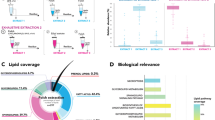Abstract
To characterize oxidative stress in phospholipids of normal human epidermal keratinocytes we metabolically labeled their membrane phospholipids with a natural oxidation-sensitive fluorescent fatty acid, cis-parinaric acid, and exposed the cells to two different sources of oxidants—a lipid-soluble azo-initiator of peroxyl radicals, 2,2'-azobis(2,4-dimethyl-valeronitrile), AMVN, and a superoxide generator, xanthine oxidase/xanthine. We demonstrated that both oxidants induced pronounced oxidation of four major classes of cis-parinaric acid-labeled phospholipids—phosphatidylcholine, phosphatidylethanolamine, phosphatidylserine, and phosphatidylinositol—in normal human epidermal keratinocytes that was not detectable as any significant change of their phospholipid composition. Vitamin E was effective in protecting the cells against phospholipid peroxidation. Since viability of normal human epidermal keratinocytes was not changed either by labeling or exposure to oxidants the labeling protocol and oxidative stress employed are compatible with the quantitative analysis of phospholipid peroxidation in viable cells.
Similar content being viewed by others
REFERENCES
Bottcher, C. J. F., Van Gent, C. M., and Pries, C. (1961) A rapid and sensitive sub-micro phosphorus determination. Anal. Chim. Acta 24:203-204.
Chavardjian, A. and Rubnicki, E. (1970) Determination of lipid phosphorus in the nanomolar range. Anal. Biochem. 36:225-226.
Folch, J., Lees, M., and Sloan-Stanley, G. H. (1959) A simple method for isolation and purification of total lipids from animal tissue. J. Biol. Chem. 226:497-509.
Jones, S. A., McArdle, F., Jack, C. I., and Jackson, M. J. (1999) Effect of antioxidant supplementation on the adaptive response of human skin fibroblasts to UV-induced oxidative stress. Redox. Rep. 4:291-299.
Kagan, V. E. (1988) Lipid Peroxidation in Biomembranes. CRC Press, Boca Raton, Florida, pp. 1-181.
Kagan, V. E., Ritov, V. B., Tyurina, Y. Y., and Tyurin, V. A. (1998) Sensitive and specific fluorescent probing of oxidative stress in different classes of membrane phospholipids in live cells using metabolically integrated cis-parinaric acid. Meth. Mol. Biol. 108:71-87.
Lee, S. C. et al. (2000) Protective role of nitric oxide-mediated inflammatory response against lipid peroxidation in ultraviolet B-irradiated skin. Br. J. Dermatol. 142:653-659.
Lehninger, A. L., Nelson, D. L., and Cox, M. M. (1993) Lipids. In: Principles of Biochemistry. Second edition. Worth Publishers, pp. 240-267.
Maziere, C., Dantin, F., Dubois, F., Santus, R., and Maziere, J. (2000) Biphasic effect of UVA radiation on STAT1 activity and tyrosine phosphorylation in cultured human keratinocytes. Free Radic. Biol. Med. 28:1430-1437.
McLean, L. R., Hagaman, K. A., and Davidson, W. S. (1993) Role of lipid structure in the activation of phospholipase A 2 by peroxidized phospholipids. Lipids 28:505-509.
Nair, J., Furstenberger, G., Burger, F., Marks, F., and Bartsch, H. (2000) Promutagenic etheno-DNA adducts in multistage mouse skin carcinogenesis: Correlation with lipoxygenase-catalyzed arachidonic acid metabolism. Chem. Res. Toxicol. 13:703-709.
Pugliese, P. T. (1995) The skin, free radicals, and oxidative stress. Dermatol. Nurs. 7:361-369.
Rashba-Step, J., Tatoyan, A., Duncan, R., Ann, D., Pushpa-Rehka, T. R., and Sevanian, A. (1997) Phospholipid peroxidation induces cytosolic phospholipase A p activity: membrane effects versus enzyme phosphorylation. Arch. Biochem. Biophys. 343:44-54.
Shvedova, A. A. et al. (2000) Redox cycling of phenol induces oxidative stress in human epidermal keratinocytes. J. Invest. Dermatol. 114:354-364.
Van der Vliet, A. and Bast, A. (1992) Effect of oxidative stress on receptors and signal transmission. Chem. Biol. Interact. 85:95-116.
Wells, P. G., Kim, P. M., Laposa, R. R., Nicol, C. J., Parman, T., and Winn, L. M. (1997) Oxidative damage in chemical teratogenesis. Mutat. Res. 396:65-78.
Youn, Y. K., Lalonde, C., and Demling, R. (1992) Oxidants and the pathophysiology of burn and smoke inhalation injury. Free Radic. Biol. Med. 12:409-415.
Zhao, J., Lahiri-Chatterjee, M., Sharma, Y., and Agarwal, R. (2000) Inhibitory effect of a flavonoid antioxidant silymarin on benzoyl peroxide-induced tumor promotion, oxidative stress and inflammatory responses in SENCAR mouse skin. Carcinogenesis 21:811-816.
Author information
Authors and Affiliations
Rights and permissions
About this article
Cite this article
Shvedova, A.A., Tyurina, Y.Y., Tyurina, V.A. et al. Quantitative Analysis of Phospholipid Peroxidation and Antioxidant Protection in Live Human Epidermal Keratinocytes. Biosci Rep 21, 33–43 (2001). https://doi.org/10.1023/A:1010430000701
Issue Date:
DOI: https://doi.org/10.1023/A:1010430000701




